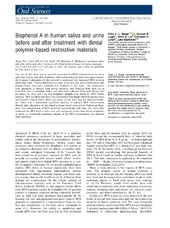Bisphenol A in human saliva and urine before and after treatment with dental polymer‐based restorative materials
Berge, Trine Lise Lundekvam; Lygre, Gunvor Bentung; Lie, Stein Atle; Lindh, Christian H; Björkman, Lars
Peer reviewed, Journal article
Published version

Åpne
Permanent lenke
https://hdl.handle.net/1956/21398Utgivelsesdato
2019Metadata
Vis full innførselSamlinger
Originalversjon
https://doi.org/10.1111/eos.12647Sammendrag
The aim of this study was to quantify bisphenol A (BPA) concentrations in saliva and urine before and after treatment with dental polymer-based restorative materials to assess if placement of this material is associated with increased BPA levels in saliva and urine. Twenty individuals in need of at least one dental restoration with polymer-based restorative material were included in this study. The participants were instructed to abstain from eating, drinking, and brushing their teeth for at least 10 h prior to sampling. Saliva and urine were collected before and 10 min (saliva only), 1 h, 24 h, and 1 wk after treatment. Samples were stored at 80°C before analyses. BPA in saliva and urine was determined with liquid chromatography/mass spectrometry. Linear mixed effects regression models were used for statistical analyses. There was a statistically significant increase of salivary BPA concentration directly after placement of the dental polymer-based restorations. Following placement, the concentration of BPA decreased exponentially with time. One week after treatment the BPA level in saliva was only marginally higher than before treatment. In urine, no statistically significant change of the BPA concentration was detected after treatment.
